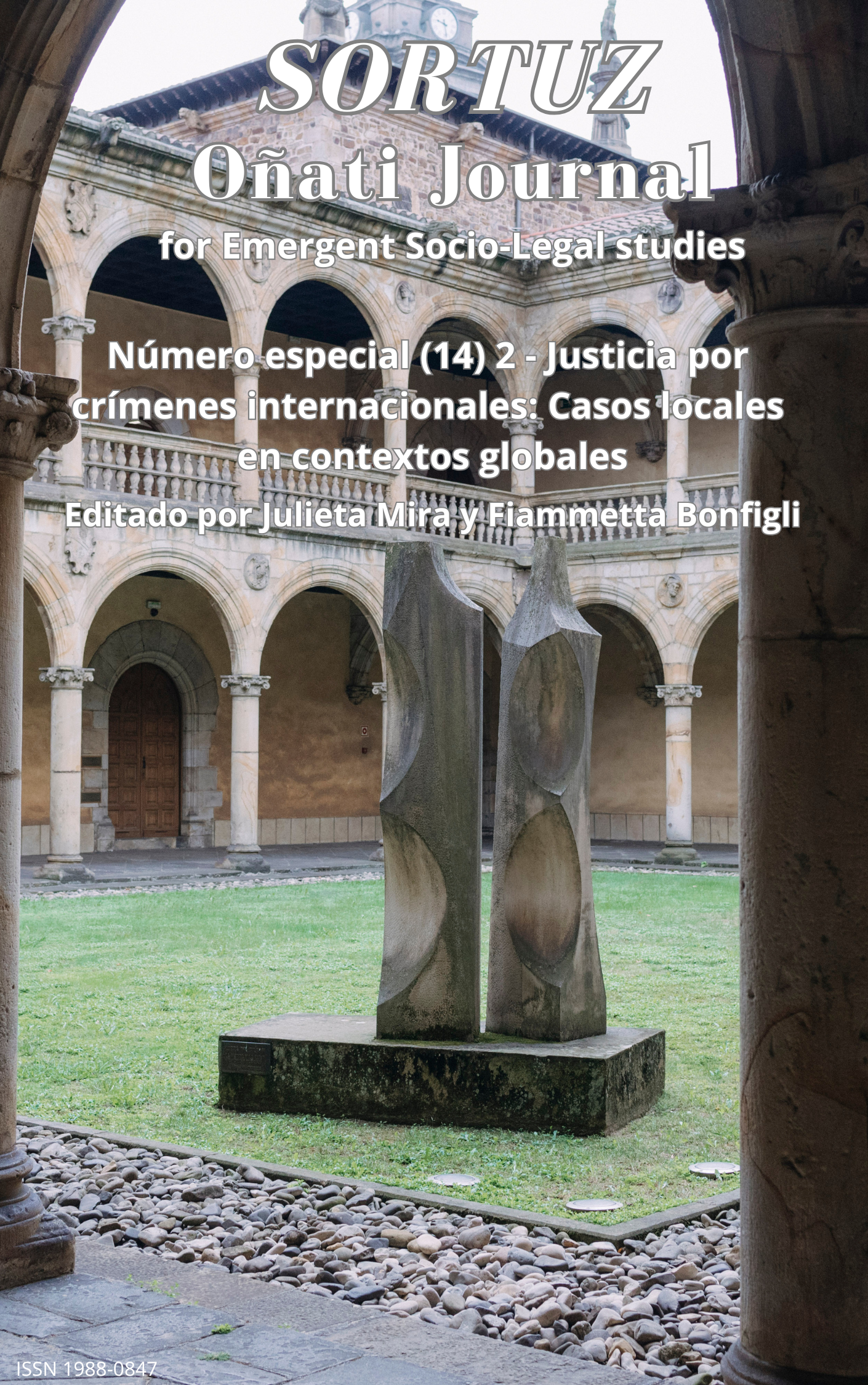Gender stereotypes and adolescent girls deprived of liberty in Chile
Keywords:
Adolescent girls, deprivation of liberty, gender stereotypes, human rights, juvenile penal systemAbstract
This paper briefly discusses the presence of gender stereotypes in the treatment of adolescent girls deprived of their liberty in Chile. The paper begins by presenting the concept of gender stereotypes and reviewing the main recommendations from the international human rights framework regarding the need to eliminate stereotypes in the justice system in general and in the treatment of adolescent girls deprived of their liberty in particular. It then uses interviews with professionals who work directly with adolescent girls deprived of their liberty to explain, through their words, the main gender stereotypes present in relation to them, which are mainly related to characteristics such as the emotionality, intensity and complexity of adolescent girls. In addition, the analysis of the interviews conducted with the adolescent girls who were in the centres at the time of the visits and who agreed to participate in the study is also included. Finally, a brief reflection is presented on the presence of these stereotypes and how they have their origin in the gender order, the socialisation that the girls receive, and also the violence to which they are exposed, to conclude by reflecting on the State's inability, to date, to provide the conditions and tools for the treatment of adolescent girls deprived of liberty free of gender stereotypes, thus complying with human rights recommendations.
Downloads
Global Statistics ℹ️
|
269
Views
|
253
Downloads
|
|
522
Total
|
|
References
Aedo, M., 2022. Adolescencia Femenina y Control Penal. Buenos Aires: Didot.
Aedo, M., Collell, A., y Varela, P., en prensa, 2024. The right to comprehensive reparation of adolescents deprived of liberty: Do public policies in Chile incorporate the perspective of gender and human rights? En: A. Chamberlen y M. Bandyopadhyay, eds., Geographies of Gendered Punishment: Women’s Imprisonment in Global Context. Londres: Palgrave.
Aedo, M., Varela, P., y Romero, L., 2024. Estándares de tratamiento de las adolescentes privadas de libertad en Chile: un análisis desde la perspectiva de género y derechos humanos. En: J.A. Fernández y R. Lorca, eds., Feminismo y Derecho Penal. Valencia: Tirant lo Blanch.
Aedo, M., y Collell, A., 2017. Las adolescentes infractoras y el sistema de responsabilidad penal adolescente en Chile: el problema de las pocas olvidadas. En: B. Amaral Machado y A. Pereira, eds., Justiça Juvenil: Paradigmas e experiencias comparadas. Brasilia: Marcial Pons.
Amsellem-Mainguy, Y., Coquard, B., y Vuattoux, A., 2018. Normes sociales, sexuelles et genrées des jeunes détenus en France au moment de leur passage à l’âge adulte. Revue Jeunes et Societe [en línea], 3(1), 114–132. Disponible en: https://doi.org/10.7202/1075771ar
Asociación para la Prevención de la Tortura y Reforma Penal Internacional, 2013. Mujeres privadas de libertad: una guía para el monitoreo con perspectiva de género [en línea]. Disponible en: https://www.apt.ch/sites/default/files/publications/women-in-detention-es-1.pdf
Bergsmann, I., 1989. The forgotten few: Juvenile female offenders. Federal Probation, 53(1), 73-78.
Bodelón, E., y Aedo, M., 2015. Las niñas en el Sistema de Justicia Penal. Anales de la Cátedra Francisco Suárez [en línea], vol. 49, pp. 219-236. Disponible en: https://doi.org/10.30827/acfs.v49i0.3283
Cámara de Diputados, 2015. Evaluación de la Ley N°20.084. Que establece un sistema de responsabilidad de los adolescentes por infracciones a la ley penal [en línea]. Disponible en: https://www.evaluaciondelaley.cl/wp-content/uploads/2019/07/responsabilidad-penal-adolecente.pdf
Chesney-Lind, M., y Pasko, L., 2004. The Female Offender: Girls, Women and Crime [en línea]. Londres: Sage. Disponible en: https://doi.org/10.4135/9781452232157
Cook, R., y Cusack, S., 2010. Estereotipos de género. Perspectivas Legales Transnacionales [en línea]. Bogotá: Profamilia. Trad.: A. Parra. Disponible en: https://www.law.utoronto.ca/utfl_file/count/documents/reprohealth/estereotipos-de-genero.pdf
Diniz, D., 2017. Meninas fora de lei. A medida socioeducativa de internação no Distrito Federal [en línea]. Brasilia, DF: Anis Instituto de Bioética/LetrasLivres. Disponible en: https://anis.org.br/wp-content/uploads/2022/10/Anis-Meninas-fora-da-lei-2017-2.pdf
Estevez Grillo, N., y García, C., 2020. Fuerza para subir, coraje en el descenso: un estudio sobre la resistencia de las niñas en medida socioeducativa de internamiento en Brasil. Oñati Socio-Legal Series [en línea], 10(2), pp. 332-362. Disponible en: https://doi.org/10.35295/osls.iisl/0000-0000-0000-1046
López Gallego, L., 2014. Proceso de reflexividad en un contexto de privación de libertad de adolescentes mujeres. Psicologia & Sociedade [en línea], 26(3), pp. 603-612. Disponible en: https://doi.org/10.1590/S0102-71822014000300009
Meis Knupfer, A., 2001. Reform and Resistance: Gender, Delinquency, and America's First Juvenile Court. Nueva York: Routledge.
Montenegro Pessoa de Mello, M., ed., 2015. Dos espaços aos direitos. A realidade da ressocialização na aplicação das medidas socioeducativas de internação das adolescentes do sexo feminino em conflito com a lei nas cinco regiões [en línea]. Brasilia, DF: Conselho Nacional de Justiça. Disponible en: https://www.cnj.jus.br/wp-content/uploads/2011/02/cb905d37b1c494f05afc1a14ed56d96b.pdf
Moreau, S., 2004. The Wrongs of Unequal Treatment. University of Toronto Law Journal [en línea], 54(3), pp. 291-326. Disponible en: https://doi.org/10.1353/tlj.2004.0010
North Carolina Office of the Juvenile Defender, 2012. Representing Girls in the Juvenile Justice System [en línea]. Informe. Agosto. Disponible en: https://www.ojp.gov/ncjrs/virtual-library/abstracts/representing-girls-juvenile-justice-system
Pasko, L., 2010. Damaged daughters: The history of girls’ sexuality and the juvenile justice system. The Journal of Criminal Law & Criminology [en línea], 100(3), pp. 1099-1130. Disponible en: https://scholarlycommons.law.northwestern.edu/cgi/viewcontent.cgi?article=7370&context=jclc
Servicio Nacional de Menores, 2019. Anuario Estadístico. Disponible en: https://www.sename.cl/web/wp-content/uploads/2021/04/Anuario-Estadistico-2019-vf-05-04-21.pdf
Shufelt, J., y Cocozza, J., 2006. Youth with mental health disorders in the Juvenile Justice System: results from a Multi-State Prevalence study, Research and Program Brief [en línea]. Delmar: National Center for Mental Health and Juvenile Justice. Disponible en: https://www.ojp.gov/ncjrs/virtual-library/abstracts/youth-mental-health-disorders-juvenile-justice-system-results-multi
Unicef, 2011. Estado mundial de la Infancia 2011. La adolescencia. Una época de oportunidades [en línea]. Nueva York: Unicef, División de Comunicaciones. Disponible en: http://www.unicef.es/sites/www.unicef.es/files/EMI2011.pdf
Unicef, CIDENI y DPP, 2020. Análisis del sistema de responsabilidad penal adolescente [en línea]. Julio. Disponible en https://www.unicef.org/chile/media/3901/file/LRPA.pdf
Valenzuela, C., y Villavicencio, L., 2015. La constitucionalización de los derechos sexuales y reproductivos: Hacia una igual ciudadanía para las mujeres. Ius et Praxis [en línea], 21(1), 271-314. Disponible en: https://doi.org/10.4067/S0718-00122015000100008
Vinet, E., y Alarcón, P., 2009. Caracterización de personalidad de mujeres adolescentes infractoras de ley: Un estudio comparativo. Paidéia [en línea], 19(43), 143–152. Disponible en: https://doi.org/10.1590/S0103-863X2009000200002
Published
How to Cite
Issue
Section
License
Copyright (c) 2024 Marcela Aedo Rivera, Andrea Collell, Patricia Varela

This work is licensed under a Creative Commons Attribution 4.0 International License.
Sortuz: Oñati Journal of Emergent Socio-Legal Studies provides immediate open access to all its content on the principle that making research freely available to the public supports a greater global exchange of knowledge.
All articles are published under a Creative Commons Attribution 4.0 International License.
Copyright and publishing rights are held by the authors of the articles. We do, however, kindly ask for later publications to indicate Sortuz as the original source.













